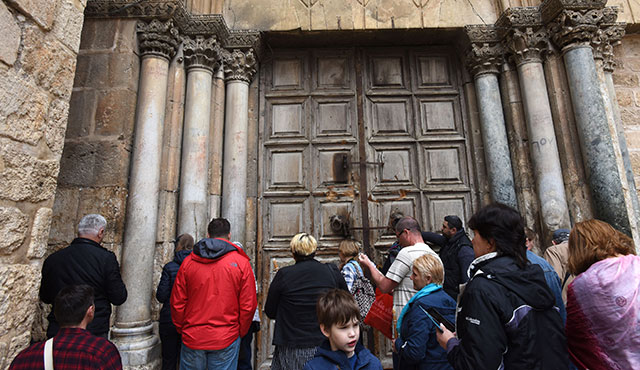Siblings don’t always get along, particularly among families that somehow make a sport of putting the “fun” in “dysfunctional.” The older brother wants control as the firstborn. The baby of the clan may feel discounted or ignored. And the middle child is continually pulled in every direction. Things can – and usually do – get messy. We’ve all seen it; many of us have even lived it.
In the same fashion, three “siblings” – the Greek Orthodox, Armenian Orthodox and Roman Catholic churches – have been bickering over access to the Church of the Holy Sepulchre, the most famous church in the Old City of Jerusalem. However, by partaking in a centuries-old ritual, two Muslim families have helped mediate the ongoing disagreement. Thanks to their efforts, today the Christian denominations live in peaceful coexistence.
For a very long time, the three denominations have fought for control of the church; each group has its own unique customs and rituals. Wajeeh Nuseibeh and Adeeb Joudeh have worked together to keep the church open for Christians – and visitors of every religion. The Nuseibeh and Joudeh families have been doing so for centuries. Every day, Adeeb carries a large cast-iron key to the church, where Wajeeh uses it to open and close the door.
The key that Nuseibeh and Joudeh use represents access to one of the most important settings in Christianity. The Church of the Holy Sepulchre, a center for pilgrims from throughout the world, is the site where Jesus was crucified and where His empty tomb resides, according to traditions that go back to the 4th century. (Others believe that Jesus’ resurrection took place at the nearby Garden Tomb.) Four Stations of the Via Dolorosa, which represent the final act of Jesus’ Passion, are located within the church.
“The pilgrims are immediately struck by the sight of the ancient stones, which comprise this church, built over the place where Our Lord was crucified,” says Fr. Scott Borgman, Judicial Vicar for the Diocese and Parochial Vicar of Our Lady of Mount Carmel Catholic Church. “Scriptural and archaeological evidence attest that this area was a disused quarry with a tomb dug out of the rock face with a low opening capable of being closed over by a stone.”
The agreement to share the church resulted from the Status Quo of the Holy Land Sites, a 150-year-old compromise between the denominations.
“If the key would be in the hands of the Greek Orthodox, then that would signify they are owners of the church,” Nuseibeh told the Catholic News Service. “If it is in the hands of the Catholics, then it would be a Catholic church; the same with the Armenian Orthodox. So Muslims are neutral people to open and close the church.”
The Nuseibeh name reportedly originated from Nuseibeh bint Ka’ab, a female companion of the prophet Muhammad. The Muslim family first arrived in Jerusalem in the 7th century, following the Arab-Islamic takeover of Jerusalem. The church’s key was given to them after an influential family member, Ubada Ibn Al-Samet, was appointed governor. The Joudehs, who came to Jerusalem at the same time, have shared the responsibility of protecting the key and the church.
The key itself isn’t something available at your local Home Depot. The “new” 500-year-old cast-iron key is 12 inches long, with a square end and a triangular handle; the original 850-year-old key broke after being handled for centuries.
The church is open every day. In the early morning, Joudeh carries the ancient key from his home through Old Jerusalem’s streets to the church, where he meets Nuseibeh at 4 a.m. Joudeh then hands the key to Nuseibeh. A “simple opening” occurs when an official from one of the Christian communities, overseen by Nuseibeh, opens only one of the door’s two leaves. When a “solemn opening” takes place, both leaves are open, one by a Christian official and the other by Nuseibeh.
The ritualistic closing of the doors occurs in the same manner, in reverse order. The church is closed at 7 p.m. between October and March, and at 9 p.m. between April and September. At closing time, officials from each of the three Christian denominations meet and discuss who will partake in the opening ritual the following day.
Time has taken its toll on the church, particularly Jesus’ Tomb. So in 2016 and early 2017, specialists from Greece, the same team that had restored the Acropolis in Athens, refurbished the ancient tomb. It had been exposed to humidity and water, candle wax, smoke and pigeon droppings. In addition to the cleaning process, the $3.7 million project included the removal of what had essentially been a giant cage constructed around the tomb 70 years earlier to prop up the walls.
The Church of the Holy Sepulchre will remain a special place for Christians of all denominations. “Nowhere on earth do we feel closer to the Redemption of humanity than in this place where Our Lord paid the ultimate price for our Salvation,” says Fr. Borgman.

